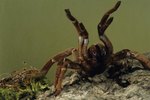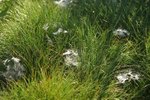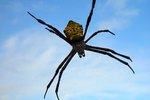
While you might have seen hundreds of spiders (order Araneae) lurking in your lifetime, you probably never looked for signs of a mouth. Spiders do indeed have mouths. Although they have tiny mouths, the arachnids, unlike many animals, don't have the ability to chew their food.
Spider Mouthparts
Spiders differ from insects in a variety of ways. Insects, for one, can chew, courtesy of their mandibles. Spiders lack mandibles for chewing. They make up for that with their chelicerae -- jaws with sharp edges, their mouthparts. The appendages are reminiscent of fangs. Spiders employ their chelicerae to seize and immobilize their prey targets. The chelicerae attach to their venom glands. Spiders also have tiny mouthparts in the back of their chelicerae -- the labrum and labium. These parts, in conjunction with the chelicerae, are responsible for aiming food inside the arthropods' mouths for consumption.
Spider Eating Styles
Spiders feed using a couple of distinct methods. They sometimes douse their foods using digestive substances, only to follow by carefully crushing everything with their jaws. They also sometimes insert the substances inside their prey as a means of liquefying the inside portions of the prey's bodies. When they do this, it enables them to literally slurp them out with their chelicerae. While many spiders can eat food after it has been thoroughly crushed, not all of them can. Cobweb spiders, for example, have no option but to take in food as liquid.
Pedipalps and Feeding
The pedipalps are another key component of spiders' mouths. Physically speaking, pedipalps are similar to tiny limbs. Their function isn't that of limbs, however. Pedipalps assist the arthropods in detecting things in their surroundings. Many spiders rely on their pedipalps for trapping prey and grinding them down. The pedipalps' duties aren't restricted to just those things. They're handy for mating, too. Male spiders send sperm to females via the pedipalps.
Location of Spider Mouths
Spiders' bodies are made up of two segments. These segments are the cephalothorax and the stomach. The stomachs are situated in back of the cephalothoraces, which house all of their body parts that are related to mating and digestion. Their mouths are located on their heads in the anterior of the cephalothoraces, along with their chelicerae, pedipalps and eyes.
References
- Plants & Animals; Laurie Triefeldt
- Exploring Life Science; Marshall Cavendish
- Spiders; Rhonda Lucas Donald and Kathleen W. Kranking
- The Safe and Effective Use of Pesticides; Patrick J. Marer
- University of Kentucky Entomology: Spider Anatomy
- University of Michigan BioKids: Spiders
- Missouri Department of Conservation: Spiders
- Deadly Spiders; Shane McFee
- Arizona-Sonora Desert Museum: Spiders
Photo Credits
-
Photodisc/Digital Vision/Getty Images



